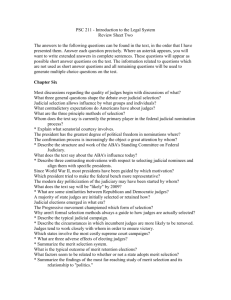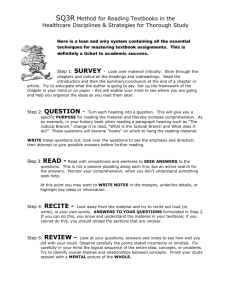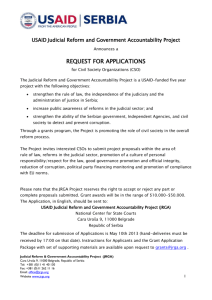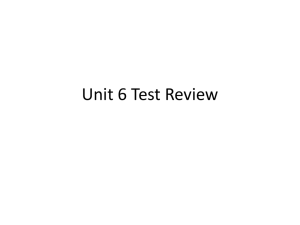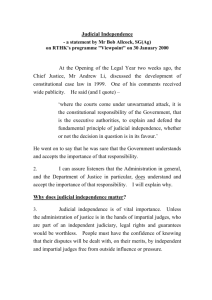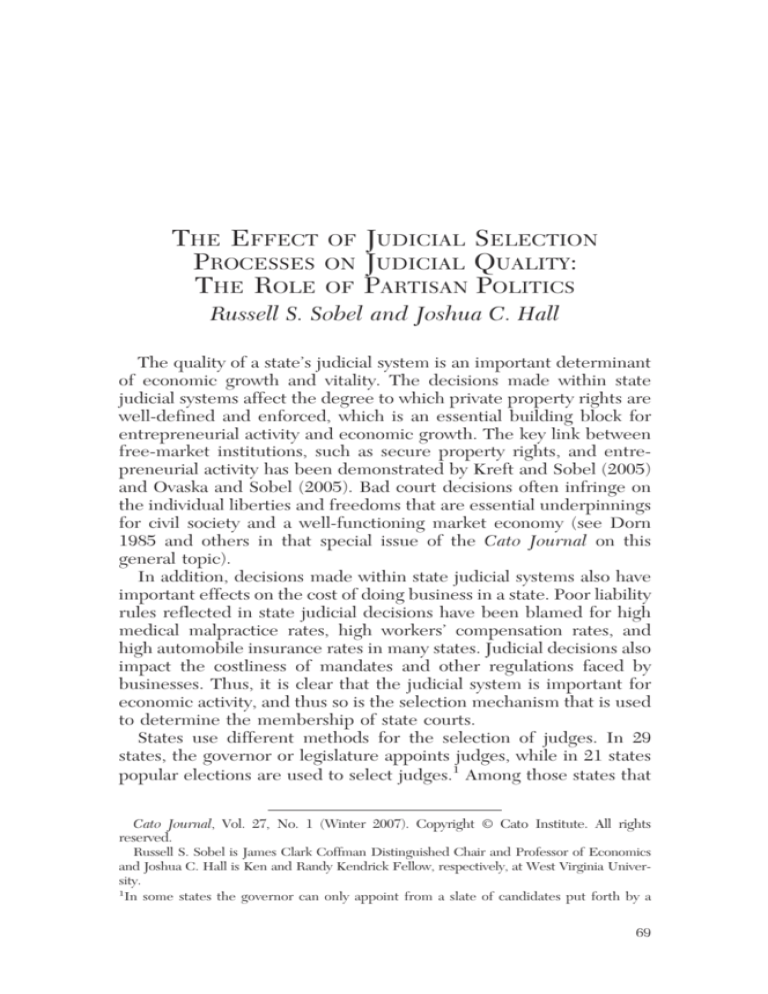
THE EFFECT OF JUDICIAL SELECTION
PROCESSES ON JUDICIAL QUALITY:
THE ROLE OF PARTISAN POLITICS
Russell S. Sobel and Joshua C. Hall
The quality of a state’s judicial system is an important determinant
of economic growth and vitality. The decisions made within state
judicial systems affect the degree to which private property rights are
well-defined and enforced, which is an essential building block for
entrepreneurial activity and economic growth. The key link between
free-market institutions, such as secure property rights, and entrepreneurial activity has been demonstrated by Kreft and Sobel (2005)
and Ovaska and Sobel (2005). Bad court decisions often infringe on
the individual liberties and freedoms that are essential underpinnings
for civil society and a well-functioning market economy (see Dorn
1985 and others in that special issue of the Cato Journal on this
general topic).
In addition, decisions made within state judicial systems also have
important effects on the cost of doing business in a state. Poor liability
rules reflected in state judicial decisions have been blamed for high
medical malpractice rates, high workers’ compensation rates, and
high automobile insurance rates in many states. Judicial decisions also
impact the costliness of mandates and other regulations faced by
businesses. Thus, it is clear that the judicial system is important for
economic activity, and thus so is the selection mechanism that is used
to determine the membership of state courts.
States use different methods for the selection of judges. In 29
states, the governor or legislature appoints judges, while in 21 states
popular elections are used to select judges.1 Among those states that
Cato Journal, Vol. 27, No. 1 (Winter 2007). Copyright © Cato Institute. All rights
reserved.
Russell S. Sobel is James Clark Coffman Distinguished Chair and Professor of Economics
and Joshua C. Hall is Ken and Randy Kendrick Fellow, respectively, at West Virginia University.
1
In some states the governor can only appoint from a slate of candidates put forth by a
69
CATO JOURNAL
elect judges, 8 rely on partisan elections, in which the judicial candidates run as a member of a particular political party, while the 13
other states use nonpartisan elections.2
The extremely politicized nature of partisan elections casts some
doubt on their ability to efficiently select unbiased judges. The 2004
state supreme court election in West Virginia provides a good example. This was the most expensive judicial election in the nation in
2004, with the Democratic incumbent spending $376,000 to the opponents $540,000. In addition, this spending was dwarfed by the
spending on political advertisements and publicity by other groups in
the state. One pro-incumbent group spent more than $1 million by
itself, while the largest anti-incumbent group spent $2.5 million. The
organized labor union interests in the state took the incumbent’s side
while the business associations supported the challenger. The candidates themselves ran on political platforms reflecting their party affiliation. The incumbent, well known for his reputation of deciding
cases for labor interest and against business interests, stressed this
reputation in his media ads, while the challenger outwardly vowed to
decide cases in a more business friendly manner if he were to be
elected.
In partisan election states, citizens are used to this political bias in
judicial elections, and there is no veil of judicial decisions being unbiased. Public opinion polls from these partisan election states confirm this claim. Geyh (2003) cites polls from Texas and Ohio that find
more than 80 percent of adults believe that campaign contributions to
judges running for election have a significant influence on subsequent
judicial decisions they make.
If an unbiased and fair judicial system is important, it is clear that
having judicial candidates run for office on political platforms, with
heavy support from labor or business groups, works contrary to this
goal. In this article, we focus on two issues related to the determinants
of judicial quality. Do states using partisan elections have lower judicial quality? If so, do states with partisan judicial elections have
judicial outcomes that clearly differ depending on which political
party controls the court?
nominating commission; however, the governor generally appoints some or all of the members of this nominating committee. For this reason, the literature generally does not make
a distinction between these two alternatives (see Helland and Tabarrok 2002).
2
The states using partisan elections are Alabama, Illinois, Louisiana, Michigan, Pennsylvania, Ohio, Texas, and West Virginia. Note that while party affiliations do not appear on the
ballot in Ohio, candidates are nominated for the court by a party and thus are considered
to be running in a partisan election.
70
JUDICIAL SELECTION PROCESSES
The article proceeds by first reviewing the previous literature on
judicial appointment versus judicial election. We then continue by
presenting data on the quality of state judicial systems and on other
measures of judicial outcomes, and attempt to uncover the impact of
partisan elections, and of specific party control.
Literature Review
An enduring question in the existing literature is whether judges
should be appointed or elected. This topic has engendered considerable debate among scholars and according to Dubois (1986) is the
single most discussed topic in legal scholarship. Among the many
arguments put forth by those in favor of appointing judges instead of
electing them is the hypothesis that judicial elections undermine public confidence in the judiciary and thus are incompatible with a strong
and independent judiciary (see, e.g., Link 2004). The research on this
topic is so large and extensive that we refer the reader to Hanssen
(2004) for a more comprehensive review. However, for our purposes,
we focus here specifically on several recent studies that examine
specific measurable outcomes of the judicial process, and how those
outcomes differ between the two groups of states.
In a study of state employment discrimination charges filed during
the 1973 to 2000 period, Besley and Payne (2003) find that states
appointing their judges have significantly lower levels of filings when
compared with states electing their judges. They hypothesize that
there are two potential reasons why judicial outcomes may differ
between elected and appointed systems. First, the choice of the judicial selection method might cause a difference in what types of
individuals actually become judges. This can happen not only because
the selection criteria is different, but also because different types of
potential judges may self-select into the potential pool of judicial
candidates. The second source of potential difference stems from the
incentive effects created by the need for elected judges to face popular reelection. Facing a reelection constraint may alter the incentives
judges face when deciding cases. Besley and Payne conclude that it is
the incentive effect of facing reelection that causes the difference
they document in their data.
Tabarrok and Helland (1999) and Helland and Tabarrok (2002)
examine state tort awards, and hypothesize that when state judges are
elected they will have a stronger incentive to redistribute wealth from
out-of-state businesses to in-state plaintiffs (who are, of course,
71
CATO JOURNAL
voters). Their prediction is that states with judicial elections should
have larger trial awards. In addition, they predict this effect to be
even larger in states using partisan elections. Using large samples of
cases from across the United States, they find strong support for their
hypothesis that elections, and their partisan nature, matter in both of
their studies. Thus, like Besley and Payne (2003), Tabarrok and Helland (1999) and Helland and Tabarrok (2002) find that judicial outcomes differ significantly between states electing judges and those
appointing judges.
In addition to examining differences between states that elect
judges and those that appoint judges, the literature has also examined
whether there exist differences between states electing their judges
on a partisan basis and those electing judges on a nonpartisan basis.
Hanssen (2000) finds, for example, that partisan elected judges side
less frequently with challengers to a regulatory status quo, and Hall
and Brace (1996) find that partisan elected judges dissent less frequently on politically controversial issues. Even within the literature
on the importance of judicial independence, such as Hanssen (2004),
judges elected on a partisan basis are considered the category least
independent, with nonpartisan elections being the second least independent.
Absent from this previous literature, however, is an analysis of
whether the outcomes from judicial systems using partisan elections
differ depending on which political party holds a majority in the court.
That is, is there evidence that judicial outcomes differ between Republican majority state courts and Democratic majority state courts?
The absence of an inquiry into whether party control matters in state
judicial systems is made more intriguing by the relative abundance of
literature on how party control affects legislative and executive decisionmaking and outcomes. Even when party control is not a primary
focus of the study, political party affiliation is nearly always included
as a control variable to capture any party control effect. Some recent
representative studies of this literature are Pjesky and Sutter (2002)
and Lopez and Sutter (2004).
The issue of whether party control matters for judicial outcomes is
uniquely important for several reasons. First, if there are differences,
previous studies that simply group them together to find the average
outcome for elected judicial systems may be averaging away the true
magnitude of this election effect. Second, to the extent that there are
differences depending on party control, this can create problems in
the long term with stability of judicial decisions in a state, creating
uncertainty and a larger amount of litigation attempting to overturn
72
JUDICIAL SELECTION PROCESSES
previous decisions.3 Finally, if we can find no difference in judicial
outcomes depending on party control this would suggest that the
substantial resources devoted by parties to win these elections represents a waste of resources from a societal perspective, equivalent to
the social losses associated with rent seeking and political lobbying in
the legislative branch of government.
Data and Empirical Findings
To measure the quality of state judicial systems we exploit a new
survey-based ranking of state legal liability systems conducted by the
U.S. Chamber of Commerce. This index scores state judicial quality
on a scale of zero to 100 based on a nationwide survey of lawyers.4
While there are potential problems with any survey-based measure,
we can see whether we can replicate the results found by other
studies comparing appointive and elective systems before proceeding
to examine the impact of party control within elected systems. If our
findings are similar, this would suggest that this measure is consistent
with other, more specific and limited measures of judicial outcomes.
However, as we proceed, we will also supplement our judicial quality
data with additional data that potentially can reflect the quality of
state judicial systems. These additional measures include state use of
eminent domain for the takings of private property, state medical
malpractice cases filed, and state unemployment compensation premiums.
Table 1 presents data showing the average state ranking and the
underlying average score by method of judicial selection. As can be
seen in the table, states selecting judges through appointment have an
average ranking in the survey of 21.1 (out of 50), with an average
underlying judicial quality score of 61.0, compared with an average
ranking of 31.5 (out of 50), and an average underlying score of 53.5,
for states selecting judges by elections. This finding is consistent with
the studies cited earlier, namely that state judicial quality declines
when elections are used to select judges. In Table 1 we also show the
average ranking and underlying score for the two subsets of elections,
3
See Hanssen (2002) for a discussion of why lawyers themselves prefer judicial selection
processes that promote uncertainty, such as merit plans for selecting judges.
4
The ranking uses a random survey of approximately 1,000 lawyers throughout the United
States. The lawyers were first asked which states they were familiar with and then were
asked to evaluate those states’ legal systems on a variety of criteria. These criteria pertained
to the perceived quality of a state’s legal system, such as judicial impartiality, judicial
competence, and overall treatment of tort and contract litigation. Their answers were then
used to construct the overall ranking.
73
CATO JOURNAL
AVERAGE
TABLE 1
JUDICIAL QUALITY RANKING
PROCESS, 2004
BY
SELECTION
Type of System
Average Ranking
Average Score
Appointed
Elected
Partisan
Nonpartisan
21.1
31.5
39.9
26.4
61.0
53.5
47.9
56.9
SOURCE: U.S. Chamber of Commerce (2004).
partisan and nonpartisan. The difference between these two groups is
even more striking than the difference between elected and appointed systems in general. States using partisan elections to select
judges have a judicial quality score substantially lower than states
using nonpartisan elections; however, both subsets remain below the
average for states that appoint judges. Thus, the selection of judges by
election lowers judicial quality, and this impact is even larger when
those elections are of a partisan nature. Both of these results are
consistent with the findings of previous literature. We now turn to
regression methodology to see whether these differences remain once
other variables are taken into account.
Our empirical specification takes the following form:
Yi = ␣i + iXi + ␦iZi + i
where Yi = judicial quality within a state as measured by a state’s score
on the state liability system ranking, Xi = a vector of control variables,
Zi = 1 if a state elects its judges and 0 otherwise, and i is the random
error term. The coefficient of interest is ␦i. A negative and statistically
significant estimate would support the hypothesis that the election of
judges decreases the quality of a state’s judicial system. A positive and
statistically significant value of ␦i would imply that judicial elections
lead to an increase in judicial quality. If ␦i is not significantly different
from zero, it would suggest that the method of judicial selection does
not influence judicial quality.
The vector of control variables, Xi, consists of state-level data that
might influence Yi, the measure of judicial quality in a state. Appendix
Table 1 gives the sources and definitions of all of the variables used
in the regression. The control variables we include reflect education
74
JUDICIAL SELECTION PROCESSES
levels within the state, number of lawyers per capita, percent voting
Democratic in the 2000 presidential election, and judicial salary level.
States with higher education levels are generally found to have better
judicial quality. Although judicial salaries are generally included in an
analysis such as ours, their impact is theoretically ambiguous. The
number of lawyers per capita should be negatively related to a state’s
judicial quality because more lawyers lower the cost of litigation
(Hanssen 1999). However, we run our regression both including and
excluding this variable because of potential problems with endogeneity. It is, of course, likely that more lawyers result from a system
with more litigation and redistribution.
The results of our regression analysis are presented in Table 2. As
expected, the sign on ELECTIVE is negative and statistically significant at the 10 percent level. The coefficient on the elective variable
can be interpreted as showing that a state moving from an elected
system to an appointive system, other things equal, could expect an
increase in their ranking on the U.S. Chamber of Commerce’s index
by around 4.5 points. Depending on where a state was in the rankings
that could be quite a significant jump. For example, fewer than 4.5
DETERMINANTS
OF
TABLE 2
STATE LEGAL LIABILITY RANKINGS
OLS Estimates
Variables
Model 1
Model 2
Constant
43.64***
(4.43)
−4.524*
(1.72)
1.063***
(3.28)
0.00003
(0.35)
−0.166
(0.90)
−2.445*
(1.72)
0.261
50
49.19***
(5.18)
−4.629*
(1.728)
0.811***
(2.74)
0.00002
(0.27)
−0.291*
(1.69)
—
—
0.229
50
Elective
Education
Salary
Democrat
Lawyers
R 2 adjusted
Observations
NOTE: *indicates significance at the 10 percent level, **at the 5 percent level, and
***at the 1 percent level. Absolute t-statistics are in parentheses.
75
CATO JOURNAL
points separate the 9th ranked state, Indiana, from the 26th ranked
state, New Jersey.
Table 3 breaks down the elective variable between those states in
which judges run in partisan elections and those in which elections
are nonpartisan. Here we wish to see whether the real difference in
judicial quality found in the regression results presented in Table 1 is
not simply a difference between elective and appointive states, but
rather between partisan elective states and appointive states. The
regression results presented in Table 3 give some credence to the idea
that it is the partisan nature of judicial elections, not just the elections
themselves, which really influence state judicial quality. The sign on
PARTISAN is negative and statistically significant at the 1 percent
level. Although the sign on NONPARTISAN is negative, it is statistically insignificant at the 10 percent level. Thus, the results in Table
3 would suggest that there is not a significant difference in judicial
quality between nonpartisan elective states and appointed states, but
that there is a significant difference for states using partisan elections.
In other words, the divergence seen between elective states and
COMPARISON
OF
TABLE 3
PARTISAN VS. NONPARTISAN ELECTIONS
OLS
Variables
Model
Model
Constant
42.373***
(4.43)
−9.360***
(2.64)
−2.091
(0.73)
0.935***
(2.91)
0.00005
(0.71)
−0.154
(0.86)
−2.072
(1.49)
0.306
50
39.881***
(3.90)
−9.526***
(2.61)
−1.364
(0.47)
0.621**
(2.22)
0.00002
(0.30)
0.010
(1.19)
—
—
0.272
50
Partisan
Nonpartisan
Education
Salary
Democrat
Lawyers
R2 adjusted
Observations
NOTE: *indicates significance at the 10 percent level, **at the 5 percent level, and
***at the 1 percent level. Absolute t-statistics are in parentheses.
76
JUDICIAL SELECTION PROCESSES
appointive states is really due to the subset of elective states using
partisan elections.
We now turn to an examination of whether party control of state
supreme courts matters in states with partisan elections. Unfortunately, given the relatively small number of states in these subsamples, regression methodology cannot be used. However,
Table 4 presents the mean values of our key measures of judicial quality, split by party control of the judicial system, as well
as showing the overall means for elected versus appointed system
states.
First, looking at the overall judicial quality scores, there appears to
be a sizable difference between partisan election states in which
the majority of the state’s highest court is Democratic and those in
which the majority is Republican. The average score for states with
Republican court majorities is 52, suggesting a higher level of judicial quality than in states with Democratic court majorities, whose
average score is 41. In Table 4 we also present a few additional,
more specific measures of outcomes of the judicial process including the usage of eminent domain, workers’ compensation premiums, and medical malpractice suits filed. In states with “worse”
judicial systems we would expect more use of eminent domain
(less secure property rights), higher workers’ compensation premiums, and more medical malpractice lawsuits. From Table 4, it is clear
that eminent domain filings occur more often in states where Republicans control the judiciary, with one filing for every 55,054
state residents compared with one filing for every 605,411 residents
of partisan election states where Democrats control the highest
court.
Interestingly, when Democratic and Republican controlled courts
are averaged together, under the category of all elected and then
compared with all appointed, this huge difference is completely
masked away by the result of averaging. Simply comparing elected
versus appointed systems might be meaningless without explicitly
controlling for party control, a potentially important problem not
addressed by the previous literature on the issue. Workers’ compensation premiums (largely dependent on court abuse of lenient benefit
provision) are twice as high in states with Democratic controlled high
courts. Again, this huge difference is masked when they are averaged
and compared with appointed states. Finally, in the case of medical
malpractice claims, which we would expect to be associated with
judicial quality, there does not appear to be any significant difference
between partisan election states where Republicans control the courts
and states where the high court is controlled by the Democrats.
77
78
OF
52.04
55,054
1.09
19.06
5
OF
40.97
605,411
2.18
19.90
3
53.50
649,719
1.26
17.13
21
Elective
STATE SUPREME COURT
Democratic
TABLE 4
CONTROL
BY JUDICIAL
Republican
OUTCOMES
Judicial Quality
Eminent Domain Filings
Workers’ Compensation Benefits
Medical Malpractice Claims
Number of observations
Variable
COMPARISON
61.00
535,418
1.25
17.36
29
Appointive
CATO JOURNAL
JUDICIAL SELECTION PROCESSES
Conclusion
The results presented here confirm previous research showing that
judicial quality is lower in states that utilize elections to select their
judges. Utilizing a new dataset measuring judicial quality across the
50 U.S. states we also find it is the partisan nature of judicial elections
that is the primary reason for lower judicial quality in elective states
that utilize partisan elections. Although regression analysis is not possible due to the limited nature of the data available, we present some
evidence that party control of a state’s supreme court seems to matter
for judicial quality and some outcomes generally considered to be
related to judicial quality, such as workers’ compensation premiums
and eminent domain usage.
As our results seem to suggest, the outcomes under partisan elections, when taken as an overall average, tend to obfuscate the markedly different outcomes between Democratic and Republican controlled courts. This party difference is important, but has been ignored in previous research. Given the vast amount of previous
literature suggesting party control of the legislative and executive
branch matters, and the commonplace acceptance of at least controlling for party control in empirical models, we believe that this phenomenon is equally important to control for in empirical analyses of
judicial outcomes. Thus we view the main contribution of our article
as the insight that it is the partisan nature of elections that causes
judicial quality to decline, not simply the electoral process as has been
the commonly accepted wisdom from previous research.
More important, this study suggests that the large sums of money
spent to influence judicial races are being spent because money can
have an impact if it affects which party controls a state’s supreme
court. This has important implications for those analyzing judicial
behavior and the impact of judicial selection processes on judicial
outcomes. Models of legislative behavior have long included party
affiliation. Perhaps it is time models of judicial behavior do the same.
Appendix: Description of Data
Appendix Table 1 provides a description of the variables used in
this article and a detailed list of the data sources.
79
80
Percentage of the state’s population 25
and older with at least a college
degree in 2003.
State population in 2003.
Number of lawyers in 2003 divided by
2003 state population.
Salary of judges of state courts of last
resort in 2003.
Dummy variable equal to 1 for states
that elected judges in 2003.
Dummy variable equal to 1 for states
that appointed judges in 2003.
Dummy variable equal to 1 for states
that elected judges in a partisan
election in 2003.
Education
Population
Lawyers
Partisan
Appointive
Elective
Salary
Ranking of the quality of a state’s
liability system on a 100 point scale.
Definition
Judicial Quality
Variable
Source
State Liability Systems Ranking Study
(2004), U.S. Chamber of Commerce,
Washington, D.C.
Statistical Abstract of the United States:
2004–2005 (2004), Bureau of the Census,
Department of Commerce, Washington,
D.C.
Statistical Abstract of the United States:
2004–2005 (2004), Bureau of the Census,
Department of Commerce, Washington,
D.C.
The Lawyer Statistical Report (2004),
American Bar Foundation, Chicago.
The Book of the States (2004), The Council
of State Governments, Lexington, Ky.
The Book of the States (2004), The Council
of State Governments, Lexington, Ky.
The Book of the States (2004), The Council
of State Governments, Lexington, Ky.
The Book of the States (2004), The Council
of State Government, Lexington, Ky.
APPENDIX TABLE 1
DESCRIPTION OF DATA
CATO JOURNAL
Democratic
Control
Republican
Control
Eminent Domain
Workers’
Compensation
Number of state residents per filed
eminent domain taking, 1998–2002.
Dummy variable equal to 1 if a state has
partisan elections and a majority of its
Supreme Court was Republican in
2003.
Dummy variable equal to 1 if a state has
partisan elections and a majority of its
Supreme Court was Democratic in
2003.
Paid medical malpractice claims per
1,000 active, nonfederal physicians,
2003.
State workers’ compensation benefits per
$100 of covered wages, 2003.
Medical
Malpractice
Democrat
Dummy variable equal to 1 for states
that elected judges in a nonpartisan
election in 2003.
Percentage of the total state popular vote
for the Democratic presidential
candidate during the 2000 election.
Nonpartisan
Statistical Abstract of the United States:
2004–2005 (2004), Bureau of the Census,
Department of Commerce, Washington,
D.C.
“Number of Paid Medical Malpractice
Claims, 2003,” Kaiser Family Foundation,
www.statehealthfacts.org.
Workers’ Compensation: Benefits, Coverage,
and Costs, 2003 (2005), National Academy
of Social Insurance, Washington, D.C.
Public Power, Private Gain (2003), Institute
for Justice, Washington, D.C.
Author calculations using justice party
affiliation information available at “Judical
Selection in the States,” American
Judicature Society, www.ajs.org/js/.
Author calculations using justice party
affiliation information available at “Judical
Selection in the States,” American
Judicature Society, www.ajs.org/js/.
The Book of the States (2004), The Council
of State Governments, Lexington, Ky.
JUDICIAL SELECTION PROCESSES
81
CATO JOURNAL
References
Besley, T., and Payne, A. (2003) “Judicial Accountability and Economic
Policy Outcomes: Evidence from Employment Discrimination Charges.”
Working Paper, London School of Economics.
Dorn, J. A. (1985) “Introduction: Economic Liberties and the Judiciary.”
Cato Journal 4 (Winter): 661–87.
Dubois, P. (1986) “Accountability, Independence, and the Selection of State
Judges.” Southwestern Law Journal 40 (May): 31–52.
Geyh, C. G. (2003) “Why Judicial Elections Stink.” Ohio State Law Journal
64: 43–79.
Hall, M. G., and Brace, P. R. (1996) “Justices’ Response to Case Facts.”
American Politics Quarterly 24: 237–61.
Hanssen, F. A. (2000) “Independent Courts and Administrative Agencies: An
Empirical Analysis of the States.” Journal of Law, Economics, and Organization 16: 534–71.
(2002) “On the Politics of Judicial Selection: Lawyers and State
Campaigns for the Merit Plan.” Public Choice 110 (January): 79–97.
(2004) “Learning about Judicial Independence: Institutional
Change in the State Courts.” Journal of Legal Studies 33 (June): 431–73.
Helland, E., and Tabarrok, A. (2002) “The Effect of Electoral Institutions on
Tort Awards.” American Law and Economics Review 4 (Fall): 341–70.
Kreft, S. F., and Sobel, R. S. (2005) “Public Policy, Entrepreneurship, and
Economic Freedom.” Cato Journal 25 (Fall): 595–616.
Link, B. (2004) “Had Enough in Ohio? Time to Reform Ohio’s Judicial
Selection Process.” Cleveland State Law Review 51:123–52.
Lopez, E. J., and Sutter, D. (2004) “Ignorance in Congressional Voting?
Evidence from Policy Reversal on the Endangered Species Act.” Social
Science Quarterly 85 (December): 891–912.
Ovaska, T., and Sobel, R. S. (2005) “Entrepreneurship in Post-Socialist
Economies.” Journal of Private Enterprise 21 (Fall): 8–28.
Pjesky, R., and Sutter, D. (2002) “Searching for Cincinnatus: Representatives’ Backgrounds and Voting Behavior.” Atlantic Economic Journal 30
(March): 74–86.
Tabarrok, A., and Helland, E. (1999) “Court Politics: The Political Economy
of Tort Awards.” Journal of Law and Economics 42 (April): 157–88.
U.S. Chamber of Commerce (2004) State Liability Ranking Study: 2004.
Washington: U.S. Chamber of Commerce.
82






